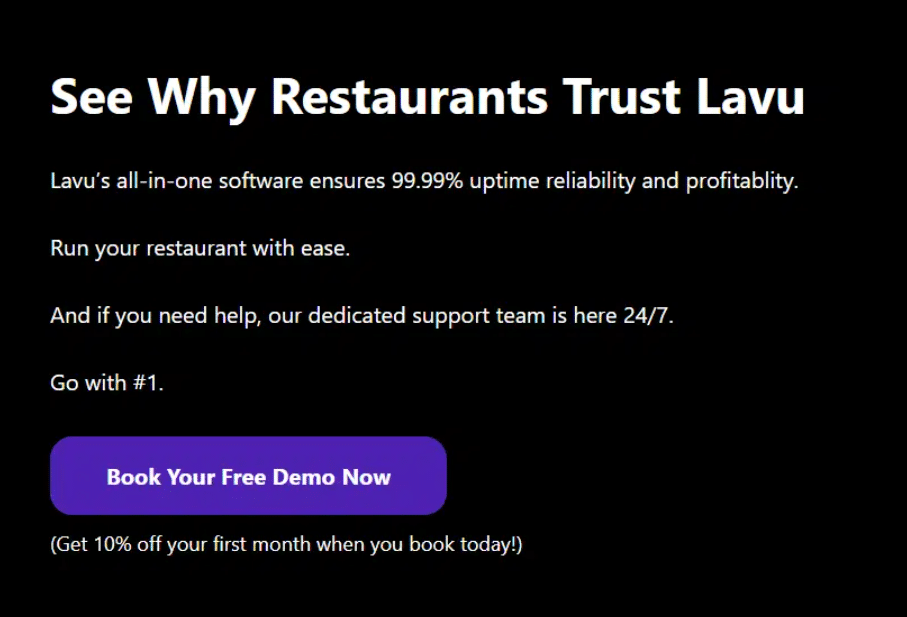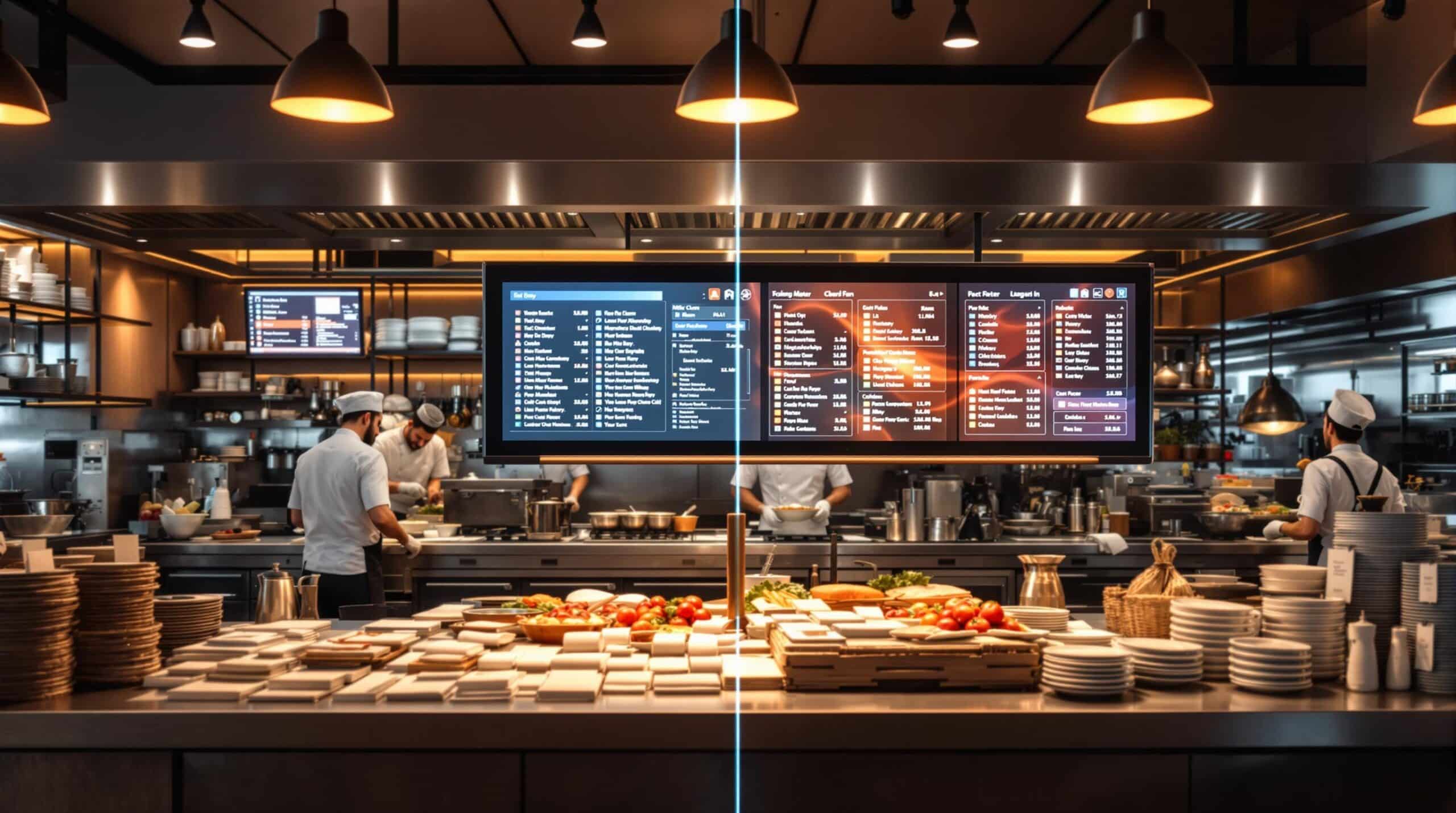Kitchen Display System Vs Traditional Order Tickets: Podcast
When it comes to streamlining operations in a busy kitchen, choosing the right order management system is crucial. Kitchen Display System vs Traditional Order Tickets has become a key debate for many restaurants. Kitchen Display Systems (KDS) have emerged as a game-changer, offering real-time updates and seamless communication between front-of-house and kitchen staff. In contrast, traditional order tickets can lead to miscommunication, delays, and inefficiency. In this post, we’ll compare Kitchen Display System vs Traditional Order Tickets to see which one truly enhances restaurant efficiency. Whether you’re looking to reduce errors, speed up service, or improve order accuracy, understanding the pros and cons of each system is the first step to making a smarter decision for your restaurant.

Which is better for your restaurant: Kitchen Display Systems (KDS) or paper order tickets? The short answer: KDS offers real-time updates, better accuracy, faster workflows, and integration with modern tools like POS systems and online ordering platforms. Paper tickets, while cheaper upfront, are prone to errors, slower to process, and lack data insights.
Key Differences at a Glance: Kitchen Display System vs Traditional Order Tickets
- Order Accuracy: KDS reduces errors by 60-80% with clear digital displays; paper tickets risk misreading or damage.
- Speed: KDS updates instantly, while paper tickets require manual sorting and delivery.
- Integration: KDS syncs with POS and inventory systems; paper tickets can’t connect to digital tools.
- Data and Insights: KDS tracks prep times and trends; paper tickets offer no analytics.
- Environmental Impact: KDS eliminates paper waste; paper tickets rely on continuous paper use.
Quick Comparison Table: Kitchen Display System vs Traditional Order Tickets
| Feature | Kitchen Display Systems (KDS) | Paper Order Tickets |
|---|---|---|
| Order Accuracy | Digital, clear instructions | Prone to handwriting errors |
| Updates | Real-time changes visible instantly | Requires reprinting |
| Speed | Faster, automated order processing | Slower, manual handling |
| Integration | Connects to POS, online orders | No digital connectivity |
| Data Tracking | Tracks performance and trends | No analytics |
| Environmental | Paperless, eco-friendly | Relies on paper |
| Cost | Higher upfront, lower long-term | Cheaper upfront, recurring costs |
KDS transforms how restaurants manage orders, improving speed, accuracy, and efficiency. For modern kitchens, the choice is clear: KDS outperforms paper tickets in almost every aspect.
Main Differences Between Kitchen Display System vs Traditional Order Tickets
Digital Systems vs. Paper Tickets
Kitchen Display Systems (KDS) are digital tools that replace paper tickets by using screens and software to manage orders. This shift eliminates the hassle of handling physical tickets and makes order management much smoother. Research shows that digital systems can reduce order errors by 60-80%.
But KDS isn’t just about going paperless – it completely changes how orders are updated and managed in real-time.
Real-Time Updates vs Static Tickets: How Kitchen Display Systems Outperform Traditional Order Tickets
KDS stands out with its ability to provide real-time updates. Unlike paper tickets, which are fixed once printed, KDS allows for dynamic tracking and instant changes. This is especially helpful during busy periods when orders or requests can change quickly.
| Aspect | KDS | Paper Tickets |
|---|---|---|
| Updates | Real-time modifications | Static, requires reprinting |
| Order Tracking | Live status monitoring | Manual checking required |
| Communication | Instant across stations | Physical delivery needed |
| Modification Handling | Immediate updates visible | New ticket required |
Integration with POS and Online Ordering Tools
KDS takes things further by seamlessly connecting with POS systems and online ordering platforms. When integrated, KDS can:
- Synchronize orders across all kitchen stations
- Update inventory automatically
- Track preparation times with precision
- Manage delivery and takeout orders effectively
For instance, Lavu’s KDS integration showcases how systems can connect with platforms like Uber Eats while maintaining smooth order flow and tracking. This not only speeds up service but also helps reduce errors, keeping customers happy.
Benefits of Using Kitchen Display Systems
Better Order Accuracy
Kitchen Display Systems (KDS) help reduce order mistakes by replacing handwritten tickets with a standardized, easy-to-read digital format. Restaurants using KDS report a 60-80% drop in order errors, ensuring meals are prepared as requested and improving customer satisfaction.
“A kitchen display system makes it easier to instantly visualize the requests and needs in front of you.”
Faster and Smoother Kitchen Operations
KDS improves kitchen workflow by organizing orders automatically based on preparation times and station assignments. This eliminates confusion and ensures tasks are prioritized correctly. Real-time updates keep every station aligned, minimizing delays and miscommunication.
| Operation Aspect | How KDS Helps |
|---|---|
| Order Processing | Sends orders instantly to stations |
| Task Prioritization | Automatically sorts by urgency |
| Station Communication | Syncs updates across all displays |
| Modification Handling | Adjusts orders instantly, no reprints |
In addition to speeding up operations, KDS provides tools to help restaurants make smarter decisions based on real-time data.
Insights from Data and Analytics
KDS collects metrics like prep times, station efficiency, order trends, and inventory usage. Restaurants can use this data to cut waste, manage staffing, and improve their bottom line.
Lavu’s KDS works seamlessly with its cloud-based POS system, offering detailed analytics to track performance and make adjustments that improve kitchen operations.
Drawbacks of Traditional Order Tickets
Errors and Miscommunication: How Kitchen Display System vs Traditional Order Tickets Reduces Mistakes
Paper tickets are prone to human error, leading to costly mistakes and inefficiencies. Poor handwriting or damaged tickets in a busy kitchen can cause confusion, forcing staff to spend extra time deciphering unclear notes or tracking down missing orders. These issues disrupt communication between the kitchen and front-of-house staff, delaying updates or changes to orders.
On top of that, the inefficiencies tied to paper systems often slow down operations, especially during peak hours when speed and accuracy are critical.
Slower Processes in the Kitchen: Why Kitchen Display System is Superior to Traditional Order Tickets
Using paper tickets can significantly slow kitchen workflows. During busy periods, staff must manually organize and prioritize orders, pulling their focus away from food preparation. If an order needs adjustment, the ticket has to be replaced or rewritten, adding unnecessary steps. Managing urgent orders also requires constant manual oversight, creating bottlenecks that reduce overall efficiency.
Lack of Integration and Insights: How Kitchen Display System Beats Traditional Order Tickets
Paper tickets fall short when it comes to integrating with modern tools or providing real-time updates. Unlike digital systems, they can’t generate useful data for improving operations. This lack of insights prevents managers from making informed decisions about staffing, menu adjustments, or workflow improvements. Additionally, paper systems contribute to waste, increasing both costs and environmental impact.
These drawbacks explain why many restaurants are turning to digital solutions like KDS to streamline operations and overcome these challenges.

System Features Compared: Kitchen Display System vs Traditional Order Tickets
When choosing between Kitchen Display Systems (KDS) and paper tickets for kitchen management, it’s important to weigh their strengths and weaknesses. Below is a breakdown of how KDS stands out when it comes to accuracy, speed, and overall functionality.
Feature Comparison Table: Kitchen Display System vs Traditional Order Tickets
| Feature | Kitchen Display Systems (KDS) | Paper Order Tickets |
|---|---|---|
| Order Accuracy | Displays orders digitally, avoiding handwriting errors; includes allergy alerts and special instructions | Handwriting can lead to misinterpretation; tickets may get damaged or lost |
| Processing Speed | Instantly sends orders to stations; updates in real time | Requires manual sorting and distribution; physical delivery slows things down |
| Integration | Syncs with POS, online ordering, and inventory systems | Lacks digital connectivity; relies on manual coordination |
| Order Updates | Changes appear instantly for all stations; clear tracking of modifications | Needs new tickets or manual edits, increasing the chance of missed updates |
| Data Tracking | Monitors prep times, identifies bottlenecks, and highlights popular dishes | No performance tracking or data collection |
| Paper Use | Reduces waste by going digital | Relies on continuous paper consumption |
| Costs Over Time | Higher upfront cost but lowers operational expenses long-term | Cheaper initially but incurs ongoing costs for paper and errors |
KDS systems bring efficiency to the kitchen, especially during busy hours. Real-time updates minimize miscommunication and delays, keeping the workflow smooth. Plus, integration with POS systems and online ordering platforms – like Lavu’s cloud-based KDS – creates a connected system that paper tickets simply can’t match.
This side-by-side look shows why many restaurants are making the switch to KDS for a more streamlined operation. Next, we’ll dive into key takeaways and tips for implementing a KDS in your kitchen.
Summary and Suggestions: Why Kitchen Display System is the Better Choice Over Traditional Order Tickets
Key Differences Recap
Research shows that restaurants using digital systems see a 60-80% drop in order errors. This highlights how a Kitchen Display System (KDS) can reshape kitchen operations by boosting accuracy, speed, and overall efficiency. Moving away from paper tickets to a digital system is a game-changer for restaurants.
Given these benefits, it’s easy to see why so many restaurants are adopting KDS to keep up with the evolving demands of the dining industry.
Why Kitchen Display System is a Better Choice for Restaurants Than Traditional Order Tickets
KDS streamlines operations, cuts down on waste, and delivers actionable data – all critical for restaurants aiming to thrive in a fast-moving environment. It addresses key challenges and helps businesses meet rising customer expectations for faster, more accurate service.
Consider Lavu for a Reliable KDS Solution
Adopting KDS isn’t just about going digital – it’s about transforming how kitchens operate. For restaurants looking to upgrade, Lavu offers a well-rounded KDS solution that integrates seamlessly with its cloud-based iPad POS system. Here’s why Lavu stands out:
- Top-rated by Capterra for three consecutive years, with an impressive 91 NPS for customer service.
- Reliable 99.99% uptime, ensuring smooth operations even during peak hours, plus integrations with platforms like Uber Eats and QuickBooks.
Switching to a KDS system isn’t just about ditching paper. It’s about leveraging technology to enhance kitchen workflows and improve customer satisfaction. With the right setup and proper staff training, restaurants can elevate their operations and stay ahead in today’s competitive dining landscape.

